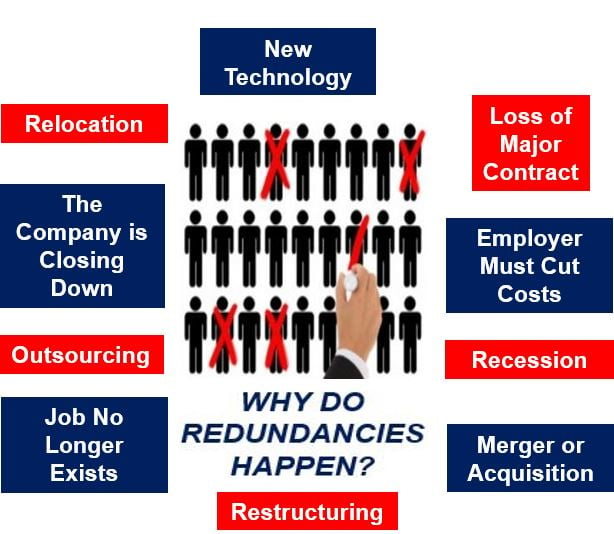Company Redundancy in the UK: Essential Steps for Companies and Employees
Company Redundancy in the UK: Essential Steps for Companies and Employees
Blog Article
Empowering Staff Members to Browse Profession Transitions Amid Firm Redundancy: Tools and Resources for Success
Browsing profession changes in the middle of company redundancy is a complex obstacle that demands strategic planning and a resistant way of thinking. From comprehending the redundancy procedure to leveraging networking possibilities, there are crucial actions that people can take to guide their jobs in a positive instructions.
Recognizing the Redundancy Refine
In navigating the complex terrain of business redundancies, a clear understanding of the redundancy procedure is paramount for employees and employers alike. Recognizing the redundancy process involves recognizing the reasons behind it, which can range from technological improvements to firm restructuring or financial slumps. It is crucial for employees to be familiar with their rights and entitlements during this period, including redundancy pay, notice durations, and accessibility to re-training opportunities or occupation transition assistance.
For employers, effective communication and transparency throughout the redundancy process are important to preserve worker spirits and trust. Offering clear explanations for the redundancy decisions, providing support services, and conducting fair option standards are crucial elements of a well-managed redundancy process. Furthermore, adherence to legal requirements and consultation commitments is important to avoid potential lawful difficulties and safeguard the company's reputation.
Structure Durability and Coping Techniques
Navigating through the difficulties of firm redundancies requires individuals to grow strength and develop effective coping strategies in order to adapt and flourish during periods of transition. Embracing a development mindset, seeing difficulties as chances for discovering and development, can even more boost strength and foster a positive approach to browsing job transitions amidst business redundancy. By proactively developing resilience and taking on reliable coping strategies, individuals can better position themselves to effectively navigate the intricacies of occupation transitions with confidence and determination.
Exploring Career Change Choices

Networking plays a vital role in revealing potential career possibilities. Engaging with sector professionals, participating in networking events, and using on-line platforms can bring about important links and insights into various occupation paths. company redundancy. Furthermore, looking for assistance from job counselors or coaches can give important recommendations and support during this transitional duration
Looking into different markets and duties can also assist people obtain a better understanding of the task market and recognize emerging trends and in-demand abilities. This details can guide them in making notified choices relating to possible career transitions and obtaining the needed credentials or experience to pursue new opportunities effectively. By checking out a vast array of occupation change alternatives, people can effectively move and navigate this difficult period towards a rewarding and fulfilling occupation path.
Leveraging Networking and Support Systems
Utilizing networking opportunities and recognized support systems contributes in helping with successful profession transitions during times of firm redundancy. Networking plays a crucial duty in attaching people with prospective task opportunities, industry understandings, and beneficial calls that can open up doors to new profession courses. Involving with professional networks, attending industry occasions, and getting to out to former colleagues or advisors can supply access to unadvertised job placements and useful recommendations on navigating career transitions effectively.
Moreover, leveraging support group such as profession counseling solutions, worker assistance programs, or industry-specific support system can supply psychological support, advice, and resources to individuals encountering redundancy. These support systems can assist in structure confidence, boosting task search strategies, and handling the emotional toll of task loss. Connecting with others that have experienced comparable profession obstacles can provide a feeling of friendship and uniformity during this transitional duration.
Using Training and Ability Development

To properly utilize training and skill growth possibilities, people should initially assess their strengths, weaknesses, and job objectives. This self-assessment can aid them determine locations where additional training is needed to boost their employability. In addition, employees should look into market trends and work demands to establish which skills are most valuable and demanded by employers.
Additionally, seeking advice from career counselors, mentors, or industry professionals can provide insights into the most advantageous training programs. Continual knowing and upskilling not just improve one's marketability but also demonstrate a proactive approach to specialist and individual growth when faced with occupation shifts.
Conclusion
In verdict, empowering workers to browse career changes in the middle of business redundancy needs an extensive understanding of the redundancy procedure, resilience-building techniques, exploration of career change choices, leveraging networking and support group, and utilizing training and ability advancement. By giving employees with the required devices and sources for success, companies can sustain their workforce in adjusting to alter and achieving lasting job growth and advancement.
Navigating job shifts amidst business redundancy is a multifaceted challenge that requires tactical preparation and a durable company redundancy state of mind. Embracing a development frame of mind, watching difficulties as opportunities for finding out and advancement, can better improve strength and promote an aggressive approach to navigating career transitions amidst firm redundancy.In the middle of business redundancy, people facing occupation changes are tasked with purposefully assessing and discovering various expert pathways to adjust and progress efficiently. By discovering a wide array of job shift options, individuals can successfully browse this challenging period and relocate towards a rewarding and fulfilling profession course.

Report this page